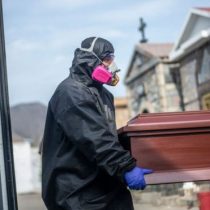
At the start of the pandemic, Peru led auspicious rankings such as that of the first countries to impose restrictions and those that earmarked the largest aid packages for people affected by the suspension of the economy.
But months later, media around the world began to report on Peru’s high spillovers, quarantine deficiencies, and the sharp economic crash hitting the country.
Now, more than five months later, the South American country is leading one of the perhaps most distressing rankings: it has the highest covid-19 mortality rate in the 20 countries most affected by the virus, according to Johns Hopkins University.
It accumulates 87.53 dead per 100,000 inhabitants. This measurement puts it ahead of countries such as the United States, Brazil and Mexico.
Peruvian media reported that this was the highest covid-19 mortality rate in the world.
In absolute terms, until this Friday, Peru was the ninth country with the most deaths in the world, with an official total of 28,277; and the fifth with the most contagion, with 621,997 cases.
5 factors that explain why strict quarantine did not prevent Peru from being the second country in Latin America with more covid-19 cases
The death toll has fallen slightly in the last week. On Wednesday, the Ministry of Health reported 123 dead, the lowest figure since June. But on Thursday it went back up to 153.
A mix of public, economic and social health factors, structural constraints and conjunctural errors explain why Peru came to this situation, says Hugo Opo, lead researcher of the Grade group, to BBC Mundo.
We analyzed four of those factors.
1. Deficiencies in the health system
Dr. Eduardo Gotuzzo, professor emeritus of Cayetano Heredia University in Lima and former director of the Institute of Tropical Medicine of that institution, points out as one of the factors of the crisis the fact that the pandemic surprised Peru with a low investment in health, with a shortage of hospital beds and intensive care, with low-paid personnel and a single laboratory capable of processing molecular tests.
The pandemic has ingested thousands of people in the country. Image copyright: GETTY IMAGES
Public spending on health, as a percentage of economic growth, has increased slightly over the past two decades.
In 2017 it reached 4.9% of GDP, according to the World Bank’s latest estimate.
But it remains “a country with low per capita spending on health, for its relative level of development,” said economist Elmer Cuba of consultancy Macroconsult.
At the start of the pandemic, Peru had 100 intensive care beds and 3,000 hospital beds.
By the end of June, it had 18,000 hospital beds, said the president, Martín Vizcarra, and now has 1,660 intensive care beds.
“But the pandemic is always one step ahead,” Dr Gotuzzo tells BBC World.
“They forgot about health and now we pay the consequences”: why Peru, a country that had great economic growth, did not invest more in its health system
Dr. Ernesto Gozzer, a public health expert at the Universidad Peruana Cayetano Heredia, acknowledges that the “state of health services has enhanced the effect on covid-19 mortality”, but does not believe that the conditions in the sector alone explain the devastation caused by the pandemic.
“If not, countries that have worse conditions than we would be much worse off,” Gozzer said.
2. Focus on intensive care rather than prevention
For Gozzer, the most important factor is “that a more hospitalocentric approach was taken than preventive and screening or public health.”
Several experts believe it is a mistake that the government has applied more quick than molecular tests. Image copyright: GETTY IMAGES
“Despite the successful early measures (school closures, borders, quarantine), the huge increase in the availability of hospitalization and intensive care (ICU) beds, and the dedication of health personnel and pandemic response officials, the results have not been as expected,” Gozzer said.
In focusing efforts on increasing the number of intensive care beds, Gozzer believes that “action has been taken on the end point of the (disease) journey reached by a person with covid-19, an intensive care bed, and that may end in death”, Said.
“Those of us who work in public health seek to contain an outbreak, that (patients) do not reach intensive care,” Gozzer said.
This approach meant that covid-19 patients could also only be treated in hospitals, rather than being able to go to health posts or medical centers (outpatient) at earlier stages of the disease, Gotuzzo explains.
Gozzer also criticizes that the government has used more serological or rapid testing as covid-19 diagnostic tests, when they serve other purposes, such as epidemiological control, rather than molecular testing.
Quick tests don’t tell you if someone is infected at the moment, but they show past infections. Molecular tests do confirm current cases of covid-19.
As of This Friday, Peru had diagnosed 154,197 cases with molecular tests and 467,800 cases, practically three times as much, with rapid testing.
But not only more molecular evidence was lacking, but also laboratories that allowed them to be processed in bulk, Says Gotuzzo.
At the start of the pandemic, Peru had a single laboratory capable of processing molecular tests. By June I was 12 and by August 10 it was already 35, among public, private and university laboratories.
“A lot of people get infected, have no early diagnosis and spread to their family,” Gotuzzo said.
“By not identifying cases in a timely manner, not following or isolating them, or tracking contacts, you do not contain the disease. The epidemic expanded further, it started to recharge services, hospitals,” says Gozzer.
Oxygen shortages have also been a problem during the pandemic in Peru. Image copyright: GETTY IMAGES
“All the time it seems like they were worried about looking for more beds, more UCI beds, when (getting to UCI) is the result I should avoid,” Says Gozzer.
“If I have 10 cases and they become 100, 200, but I keep an eye on them, they’re finished and I don’t need UCI beds. But if I let them go on because I didn’t do molecular tests, I didn’t do contact tracking, it’s going to be 1,000, 10, 000, there’s no system to resist. It is true that the system is in deficit and must be reformed, but it seems to me that the main thing is the approach,” Says Gozzer.
3. Oxygen shortage
Another problem that affected the fight against the pandemic was the shortage of oxygen.
“We had to sell almost everything to get the oxygen and that my mom wouldn’t drown”: the scarcity of vital gas in Peru by the covid-19 who put the government on alert
At various points in the emergency, the media spread images of people forming long queues to get oxygen, a demand that led many suppliers to raise input prices and open clandestine oxygen sales positions.
In June, the government declared oxygen as a product of “national interest” and ordered a purchase of close to $25 million of medical gas to meet demand.
“The lack of oxygen influenced mortality, because people who needed oxygen and that could have been cured with that probably got better and had to reach ICU or no longer made it to ICU,” Gozzer told BBC World.
4. Government reaction
At the start of the pandemic in Peru in mid-March, the government reacted quickly and decreed one of the most restrictive quarantines in the region.
At the same time, it spent between 9% and 12% of its GDP to help people who had lost their jobs (or self-employment) and companies that had been left without income because of the closure of the economy.
In May, Vizcarra recognized markets as one of the main sources of covid-19 contagion. Image copyright: REUTERS
But Hugo Opo believes that they lacked “a twist” on these measures to adapt them to Peruvian reality.
About 71% of Peru’s economically active population lives on the informal economy or performs in trades where they earn their incomes day by day, so they could not stay at home and had to go out to work on the street.
In addition, people had to go to supply themselves to crowded places such as markets, which in May Vizcarra identified as “the main sources of contagion”.
The distribution of economic bonds also led to agglomerations forming in banks, with only 38.1% of adult Peruvians having a bank account. The rest had to go in person to collect the money.
For Dr. Gotuzzo, “good social measures (bonds) ended up being negative public health measures.”
“The initial plans were somehow a copy of Europe’s strategies. We lacked to see that these strategies were not necessarily going to be successful here, with such informality. We lacked a different solution, for us,” Opo told BBC Mundo.
“No one expected the government not to make mistakes, no one knowsthe pandemic. But if we were going to make mistakes, we had to transparent them and correct them on the fly,” he added.
Once the government identified some of these problems, it took steps such as intervening and reorganizing markets, and extending banks’ hours of operation.
It also provided for the automatic opening of a savings account at The Bank of the Nation for all Peruvians over the age of 18.
Economist Janice Seinfeld, executive director of the consultancation Videnza, also noted that when quarantine and transport services were suspended, many people walked back to their home cities.
“A slightly thinner closure would have been rather more positive, it had to spin a little thinner according to national reality,” Seinfeld told BBC World.
About 120 people attended the party at Thomas Restobar. Image copyright: GETTY IMAGES
5. Compliance with restrictions
In recent days, many people held those Peruvians who failed to comply with restrictions to prevent contagion, after 13 people died last weekend and six others were injured in a stampede that occurred at a clandestine holiday in Lima.
About 120 people had attended the event at Thomas Restobar, although meetings are banned in Peru as a measure to prevent covid-19 contagion.
“They despaired and wanted to escape like it”: what happened in the stampede in a nightclub in Peru that left 13 dead
“One wonders if it was an isolated case and the answer is absolutely not. It happens in every neighborhood and it’s a rooted thing that tells us how willing we are to respect rules. Unfortunately that’s costing us,” Opo said.
Police on Thursday told el Comercio newspaper that since the start of the pandemic 321 underground parties had been involved in Lima alone.
“The tragedy represents – in a short and accelerated way – many of the yerros that have aggravated the progress of Covid-19 in the country,” said an editorial in the newspaper El Comercio published on Monday.
But “to bear most of the blame on the victims themselves is obtuse, cruel, and invisibiliary the structural shortcomings that make it possible for situations like this to be repeated,” the editorial continues.
What is known about stampede in a Peruvian nightclub that left at least 13 dead in the midst of the state of emergency by the coronavirus
Other experts and commentators also reject the culling of those attending clandestine meetings of the pandemic situation in Peru and rather re-pointing out pre-existing structural problems.
Pablo Lavado, professor of economics at the University of the Pacific, told BBC Mundo that “clandestine meetings have undoubtedly contributed to the mortality rate, but I don’t think they are the main cause, they don’t need to be attributed.”
“These are credible hypotheses, but there is no data. Also, you don’t just have to consider clandestine parties. People have continued to go out to work, it has continued to move, there has been interaction in the markets, in the banks, all that has been getting in,” Lavado said.
“They have certainly contributed (the meetings), but I have doubts about how much they have contributed. All the crowds have contributed, but I couldn’t say which else,” he says, saying, “more people are caring for each other.”
What does the government say about the high mortality rate?
Council of Ministers President Walter Martos acknowledged in an interview with Peruvian network RPP that Peru has the highest covid-19 mortality rate, but that the record is due to the government’s transparency in spreading the death tolls.
“I do not know of another country, apart from Peru, that during the pandemic is being transparent with the number of deaths during the pandemic […] There are numbers of covid-19 suspects that have passed (to the official count) and that raises the number globally,” Martos said on Thursday.





